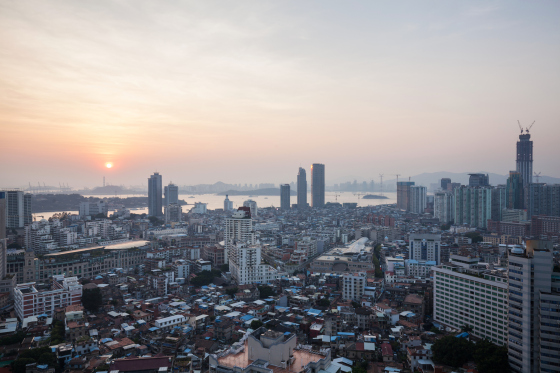There is little about the fragrant sizzle of oysters, or sheets of kelp drying by agave-fringed shores, that hints at a Cold War frontier. But on Xiaodeng, a rocky island off China’s bustling southern port city of Xiamen, seafood and subterfuge go hand in hand. Measuring less than a square mile, it is the closest inhabited part of the People’s Republic to Taiwan, whose island of Kinmen looms through the fog. Over the decades, the periodic exchange of rockets between the two foes has forced people on both sides to retreat into deep defensive tunnels hewn from the solid rock. During times of peace, a propaganda battle has often taken over.
“Taiwan used to send biscuits and even old watches over by balloon,” says a Xiaodeng resident surnamed Hong, 76, beneath an awning in her courtyard. ”But we were told they were poisoned and so never touched them.”
China and Taiwan split after Mao Zedong’s Communists forced the routed Nationalists across the Strait in 1949 at the end of China’s civil war, setting off decades of bristling rancor between the Soviet-backed victor and its American-propped foil. Beijing still considers Taiwan a renegade province to be reunited by force if necessary.
China’s State Council designated Xiaodeng and two neighboring islands—Da Deng and Jiao Yu—a “Hero’s Triangle” in 1958, owing to their frontline positions. Less than two miles separate Xiaodeng from Kinmen. That’s considerably less than the 90 miles from Cuba to Key West, and even narrower than the 2.5-mile Korean DMZ. The peoples of Taiwan and Fujian province, to which Xiaodeng belongs, may have been politically estranged for over half a century, but they share a culture, a cuisine and the Hokkien group of dialects.
In recent years, the political gap has slightly narrowed. In 1992, Beijing signed a consensus with the Kuomintang government then governing Taiwan., stating that there was “One China.” Even if the two sides disagreed over what its sovereign power should be, the consensus that there was an indivisible China was enough to send hourly ferries, packed with selfie-snapping tourists, between Kinmen and Xiamen—the island port city of which Xiaodeng is administratively a part. The consensus also prompted the launch of direct flights between various Chinese cities and Taipei.
But those warming relations have been directly challenged by new U.S. President Donald Trump. In stump speeches through the American heartland, he accused China, with its export-driven economy, of stealing American jobs. He vowed to label Beijing a currency manipulator and to impose 45% tariffs on Chinese imports. But, even worse from Beijing’s point of view, he accepted, while President-elect, a phone call from Taiwan’s President Tsai Ing-wen. A U.S. leader had not had direct contact with his Taiwanese counterpart since Washington recognized the People’s Republic in 1979. In talking to Tsai, Trump broke with four decades of diplomatic protocol and challenged what Beijing deemed its “core interests.”

A magazine featuring a front page story on Donald Trump sits on a magazine rack at a company office in Beijing on December 28, 2016. Chinese media have warned of a potential trade war with the U.S. GREG BAKER
Things have since escalated. The U.S position on China and Taiwan has long been a diplomatically nuanced acknowledgement of Beijing’s belief that there is “One China,” while holding that Washington will retain robust unofficial relations with Taiwan, to which it sells arms and to which it has pledged military assistance, should it ever come under attack from Beijing. Trump, however, has repeatedly insisted that U.S. recognition of “One China” was up for negotiation, treating it, and Washington’s obligations to the Taiwanese, as bargaining chips to be used to extract more favorable trade terms from Beijing.
Even more worryingly, Rex Tillerson, Trump’s nominee for Secretary of State, told a Senate committee that China should be barred from the seven artificial islands it has built in the South China Sea, over most of which Beijing claims sovereignty, competing with neighbors Vietnam, the Philippines, Taiwan, Malaysia and Brunei, who also claim parts of the sea. The artificial islands, built up through reclamation to bolster Beijing’s maritime claims, are mini Chinese fortresses—hosting antiaircraft guns and other sophisticated weaponry, according to recent analysis.
In a press briefing Monday, Trump’s press secretary Sean Spicer repeated Tillerson’s challenge: “It’s a question of if those islands are in fact in international waters and not part of China proper, then yeah, we’re going to make sure that we defend international territories from being taken over by one country,” Spicer said.
China’s state media has responded forcefully to the suggestion, warning that any such attempt would force a “devastating confrontation” and that both sides should “prepare for a military clash.” In the meantime, tensions are likely to escalate. Although it would benefit nobody, says Zhu Feng, professor of international relations at Nanjing University, “We cannot exclude the possibility of a new Cold War.”
‘The world is opening up, but Trump is trying to close the U.S.’
A return to those dark days would not be welcome in Xiamen, a city that symbolizes the great leaps China has made over the past four decades, as well as its lofty ambitions for the future. Even before it was ceded as a British treaty port in 1842, the city formerly known as Amoy had always buzzed with trade. Its majestic Bund is stacked with Regency-style shophouses, invoking Penang or Singapore, and similarly punctuated with the occasional ruby-red Taoist temple. From here, merchants shipped tea, lacquer, rice and spices to all over the world. And when Chinese leader Deng Xiaoping launched his “reform and opening” in 1978, Xiamen was once again at the vanguard. It was one of China’s original quintet of Special Economic Zones that opened to foreign trade in 1980, spearheading the nation’s transformation into the world’s second largest economy today.
Xiamen, like China, is changing once again. The nation that was once the butt of cruel, Made-in-China jokes is reinventing itself. Today, behind Xiamen’s pearl-white colonial terraces are glistening skyscrapers of steel and glass, where Chinese corporations extend their reach across every continent. A country that once kept its currency devalued to maintain the competitiveness of its exports is now keeping it high to stem huge capital outflows. The factories pumping out plastic toys and cheap novelties—“rubber dogshit,” to quote the immortal line from 1980s movie Top Gun—are now producing the next generation of technology.

The Xiamen skyline at dusk
Xiamen company Newyea represents this paradigm shift. Founded by 2013, and valued at $145 million, the firm pioneers the latest in contactless charging devices. It has over 100 patents and produces components for cellphone makers like Samsung, Blackberry and LG. It is also currently talking with U.S. aerospace giant Boeing about installing contactless chargers on its aircraft, an innovation that would boost aviation safety by eliminating the considerable fire hazard of live wires and sockets around every seat.
“‘Made in China’ has new meaning today, and the world is opening up, but Trump is trying to close the U.S.,” says Newyea cofounder Xu Ayi over tea in his firm’s office. “Trump’s a bad apple and even Americans need to worry about him.”
Taiwan is not just the only “core interest” attacked by Trump; foreign trade is as much part of modern Chinese DNA today as “One China.” And no one has embraced that transformation more wholeheartedly than its President, Xi Jinping. It is, in fact, part of his family legacy. Xi’s father, Xi Zhongxun, was purged and imprisoned by the Communist Party under Mao Zedong, though was later “rehabilitated” and became a key supporter of Deng’s capitalist experiments. He took various leadership roles in the southern province of Guangdong, and was instrumental in transforming it into China’s most affluent region. When Xi the younger was finally allowed to join the party, he followed in his father’s footsteps, with one of his first official roles as vice-mayor of Xiamen.
Xi was not a local. The singsong Hokkien tongue and muggy sea air were utterly alien for a northerner like him. Yet he quickly made an impression with his dedication to ensuring that Xiamen was a business-friendly environment. Xi served three years in Xiamen—where he also met and married his second and current wife, renowned singer Peng Liyuan—out of 16 years in Fujian province, during which he helped lure an influx of South Korean, Japanese and Taiwanese manufacturers. These are policy priorities that remain central to Xiamen’s identity. Newyea, for one, has received government grants of almost $1.5 million over the past three years.
“Electronics and software are the two pillar industries in Xiamen,” says chairman Lin Guijiang. “Local government has greatly subsidized these industries and that makes Xiamen a magnet for talent.”
These are also the liberal economic values that Xi has taken onto the international stage. When he became the first Chinese leader to address the World Economic Forum in the Swiss Alpine resort of Davos, Xi issued a stern defense of globalization and rebuke of Trump’s protectionism—as unlikely as that was, coming from a nominally communist leader.
“We must remain committed to developing global free trade and investment, promote trade and investment liberalization and facilitation through opening-up and say no to protectionism,” he said. “No one will emerge as a winner in a trade war.”
To be sure, there are still many barriers to such a development. Apple makes one-fifth of its sales and Boeing earns 13% of revenue in China. There are also structural impediments; the WTO was set up primarily to consign trade wars to the history books. However, many argue that the WTO has long failed in its regulatory function, and that China’s accession has not turned it into a great consumer for manufacturers looking to sell to the world’s most populous nation. Despite a raft of WTO measures, and China’s budding affluence, China’s imports have slid steadily relative to its GDP since it signed up in 2001.
